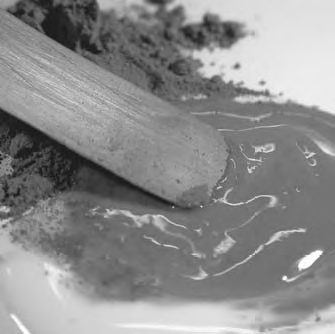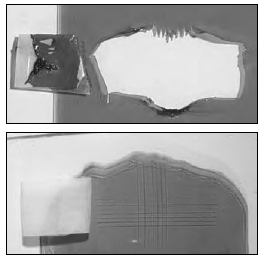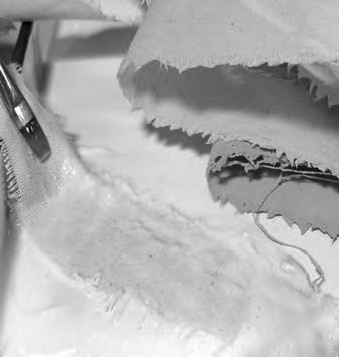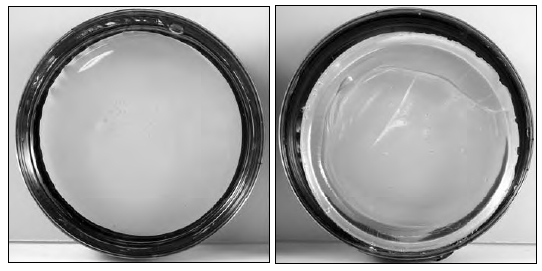By Dana Rice
You’re seated at a white clothed table in an uptown restaurant; the chef has just placed an incredible creation down in front of you. You take a bite and a complex mixture of flavors and spice awaken your palette. You can’t quite put your finger on it, but there is an ingredient that pulls the whole dish together, something added that brings out just the right flavor.
For many artists, that unique, additional ingredient for their work can be found in the line of GOLDEN products called Specialty Acrylic Polymers. Within the line, the products are identified by the letters “GAC” followed by a number. The letters “GAC” stand for Golden Artist Colors, but commonly the line of products is referred to as the “GACs” (pronounced: gaks, rhymes with yaks). The number that follows is an identifier, but does not have significance relative to any other product, or to the product’s capabilities.
The Specialty Acrylic Polymers, or GACs, are formulated based on 100% acrylic dispersion polymers with only a minimum amount of thickeners, freeze/thaw stabilizers, defoamers and preservatives. The GACs are fluid and thin, and are therefore generally considered a component to be used in conjunction with something else, rather than as a stand-alone product. Each GAC represents a unique polymer that offers certain specific attributes; therefore, each GAC will have its own unique benefits and applications. They are building blocks.
With this in mind, the GACs can be blended with GOLDEN Acrylic Paints to extend the paint, regulate transparency, create glazes, increase gloss, reduce viscosity or improve adhesion and film integrity. Since the GACs have minimal thickeners added, these polymers will reduce the thickness of most GOLDEN Acrylic Paints. GOLDEN Fluid Acrylics are slightly thicker than the GACs, but is the color line least changed in viscosity with any addition of a GAC polymer.

polymers and is useful for artists formulating their own paints.
GAC 100 is a multi-purpose acrylic polymer. GAC 100 is ideal as a sealer for protecting against Support Induced Discoloration (SID), a condition resulting from impurities that are drawn up through an unprimed substrate as the acrylic paint dries, discoloring the paint. GAC 100 is also useful for diluting and extending colors, increasing flexibility and film integrity, sizing for fabric, and sealing for wood. GAC 100 will wet out solids, including pigments, more readily than other polymers and is useful for artists formulating their own paints. GAC 100 is soft and flexible, so if the color blends get too tacky, modifying with GAC 200 will reduce the tack.Over the years, the line of GACs has been developed based on requests for different types of building blocks
containing attributes for specific applications or effects. What follows is a description of each GAC product and
its particular attributes.
Common Uses: Sizing, protection against Support Induced Discoloration (SID), linseed oil blocker, extending Heavy Body paints, paint-making with dry pigment

glass adhesion test done in the GOLDEN Lab.
GAC 200 (bottom) demonstrates its ability to
adhere to nonporous surfaces such as glass.
GAC 200 is an acrylic polymer designed for increasing film hardness. The hardest and least flexible of our polymers, GAC 200 is ideal for mixing with acrylic colors to increase film hardness and reduce dry film tack. This is particularly useful when using masking tools such as painter’s tape. The increased film hardness ensures a cleaner edge when the masking tape is removed. In addition, GAC 200 improves adhesion to non-porous surfaces; however some surfaces, such as glass and glazed tile, will not allow for a permanent bond. Due to the film hardness achievable with GAC 200, if the mixture contains more than 50% GAC 200, it is not recommended for use on flexible supports, as cracking may result. On rigid supports, a maximum of 75% GAC 200 is recommended.
Common Uses: Increase film hardness, reduce tack, masking techniques, increase adhesion on nonporous surfaces

GAC 400 is an acrylic polymer designed to stiffen natural fibers, including fabric and some types of paper. Fibers saturated with GAC 400, or GAC 400 blended with color, will dry to a hard, stiff film. Lightweight fabrics, such as cotton and linen, can be molded and shaped into fixed forms.
Common Uses: Stiffen and form fabric/paper, create sculptural elements, size canvas
GAC 500, with a unique balance of film hardness and flexibility, is the hardest acrylic polymer within the product line that is still pliable enough to be used on flexible supports. GAC 500 offers increased leveling, increased mar resistance and decreased dry film tack. The increased film hardness ensures a cleaner edge when using masking techniques. GAC 500 is particularly useful for extending Fluid Acrylic colors with minimal property change. In addition, GAC 500 can be mixed with Airbrush Transparent Extender to create a fast-drying, sprayable isolation coat.
Common Uses: Decrease brush strokes, increase mar resistance, masking techniques, base product for airbrush sprayable isolation coat
GAC 700 has higher solids in the base resin formula than most other polymers (60% versus 48%). The higher solid content increases film clarity and transparency, while minimizing shrinkage. GAC 700 is useful for sealing porous materials. Relatively soft, GAC 700 blends can result in an undesirable degree of tack. Modifying the blend with GAC 200 will reduce the tack. The GAC 700 dispersion has a tendency to generate foam during application, so care should be exercised when brushing.
Common Uses: Increase transparency, seal cork
GAC 800

applications (left). As puddles dry, uneven drying rates within the layers of the pour can result in “crazing,”
shrinkage crevices that run across the surface (right).
Common Uses: Reduce crazing with puddles and pours, increase adhesion to chalky surfacesis an acrylic polymer designed to reduce crazing in puddles, pours, and other thin pourable paint applications. As puddles dry, uneven drying rates within the layers of the pour can result in “crazing,” shrinkage crevices that run across the surface. The addition of GAC 800 to the acrylic color promotes drying with a smooth, even film. In addition, GAC 800 is also useful for adhesion to chalky surfaces. GAC 800 dries with good gloss and film flexibility, but with a slight “hazy” quality. When mixing GAC 800 with color, gently stir to avoid foaming. If foaming does occur, place the mixture in an air-tight container and allow to sit for 1-2 days, until the bubbles have enough time to rise to the top and dissipate.
GAC 900 is an acrylic polymer designed for fabric and clothing applications. When heat-set properly, the addition of GAC 900 to color lends painted fabrics a very soft hand and laundering stability. GAC 900 can be mixed with Airbrush colors to produce “tie-dye” effects on pre-wetted material, or blended with GOLDEN Heavy Body, Matte or Fluid Acrylics for brush or screen application. To further promote launderability during spray
applications, GAC 900 may be used full strength as a basecoat, as well as a thin topcoat. Optionally, GAC 900 applied as a basecoat, then heat-set, will “seal” the fabric surface prior to paint applications. For thicker screen or brush applications, mix color with Silkscreen Fabric Gel, a gel product with the same soft-hand and launderability properties of the lower viscosity GAC 900.
Note: Provide adequate ventilation when heat-setting with GAC 900 as the process releases low levels of formaldehyde.
Common Uses: Soft-hand and laundering stability for painted fabric, “tie-dye” effects
About Dana Rice
View all posts by Dana Rice -->Subscribe
Subscribe to the newsletter today!
No related Post

Can the GAC 100 be thinned with Airbrush Medium or High Flow Medium to be used in a spray solution for airbrushing? I plan on sealing Ampersand Hardbord before I gesso it.
Hi Josh –
GAC 100 can be sprayed. We would recommend blending with GOLDEN Airbrush Medium, starting at 2 parts GAC 100 to 1 part Airbrush Medium. When faster drying is required, replace the Airbrush Medium with GOLDEN High Flow Medium. We have also recently updated our recommendation around protecting fro Support Induced Discoloration and recognize that while GAC 100 still works for most normal applications, just as it has in the past, that Gloss Medium does have the edge for more extreme applications, such as thick applications of gels or pouring. Depending on your own processes, you can decide which works best for you. Again, for ‘normal’ painting, GAC 100 should be more than fine.
For the GAC 200 it says that it helps improve adhesion on non porous surfaces – but not glass or tile. I was wondering if it would work on top of epoxy resin. I wanted to paint over a resin painting and was considering using GAC 100 or 200 to provide a clear coat over the resin that I could then paint on top of (possibly with oils). Do you think this would work?
Hello Jeszika,
Thanks for your comment. Resin is a pretty tight coating, so in order to have good adhesion we recommend a light scuffing or sanding and a good cleaning to create opportunities for mechanical adhesion and remove and oils that could be on the surface. We recommend testing though just in case to be sure you achieve good adhesion. You are correct the acrylics including GAC 200 have poor adhesion to glass and glazed ceramic tiles, but GAC200 has a harder film when it dries. So if applied thinly it is harder to chip off or pick at, so it can hold up better. You would be creating a pretty complex sandwich of materials as you are describing and it is not something we have tested. You could reach out to the resin manufacturer and inquire about adhesion of oils to the resin direct and see if it can accept them and cut out the acrylic step. Let us know if you have more questions at [email protected]
Will It Stick? Simple Adhesion Testing In Your Studio
Best,
Scott
I’m planning to to seal MDF partical board before painting with acrylics. Would GAC 100/200 be a good medium for this purpose?
Regards,
Ed
Hello Ed.
You can use the GAC 100 but the Gloss Medium has proven to be the best size for reducing S.I.D. (Support Induced Discoloration). Here’s our preparing support information sheet: https://www.goldenpaints.com/technicalinfo/technicalinfo_prepsupp If you have any additional questions, please contact us at [email protected]
– Mike Townsend
Hello,
Can I use GAC 800 as a regular fluid gloss medium or just an extender like (GAC 100) for my heavy body paint with brushes? I don’t do pouring art but I have a GAC 800 and don’t know what to do with it. Also can it be used with a little retarder if applied in thin brushstroke layers?
Thank you
Hello DJ, yes, you can use GAC 800 and also GAC 100 as a painting medium with your Heavy Body paints. The GAC 800 dries slightly milky, therefore it might not be the best choice for very translucent glazes, but if you mix in at least 5-10% paint into the GAC 800, the hazy color of the GAC 800 shouldn’t be noticable. It should be fine to add retarder as well.
Best, Mirjam
I am painting on top on non traditional surfaces such as cotton fabrics and lycra. Generally, I would use GAC 400 to begin the priming process, but my local store was out. I started priming with Matte Medium, but I wanted to know if I can apply GAC 100 over the matte. Eventually oil paint will be applied to the painting (after acrylic under paintings) I am curious, will the 100 be harmful over layers of matte medium? Or does 100 always have to be the initial layer?
Hi Jonathan, Thank you for your questions. GAC 400 is a fabric stiffener for natural fibers. This could be replaced by GAC 200 if trying to stiffen the cotton, as this is one dries to the hardest film. The GAC 400 does not however, block oil penetration. Three coats of an acrylic medium like Matte Medium, GAC 100, or acrylic paint should be sufficient to block the oil penetration. It is fine to apply the GAC 100 on top of Matte Medium, but may not be necessary if you had a total of three coats with the Matte Medium nd Acrylic paint. Please allow the acrylics to dry for three days before applying the oil paint. We hope this is helpful and if you have any further questions, please feel free to email us at [email protected].
Hello,
Can I make paint just using GAC 100 and pigment?
thank you
Hello Dj, yes, the GAC 100 will be sufficient, at least for some pigments. The mineral pigments, such as natural earth pigments, wet out easily and it should be fine to mix those into a paste with water and then add GAC 100, or add GAC 100 straight away. Synthetic organic pigments, such as quinacridones or benzimedazolone pigments don’t readily mix with water and you will likely need a wetting agent to create a pigment paste with water before being able to create a good paint with GAC 100. In our Pigment ID Chart you can sort colors by their chemical category – organic (carbon based) or mineral based. When making your own acrylic paint one quickly overloads the paint with pigment which leads to mud cracking during drying. We therefore recommend keeping detailed notes of the amounts of pigment water and binder, in order to find the right ratios. Take a look at our article Just Make Paint for more detailed instructions.
I am wanting to paint a old leather recliner chairw/nailheads. I stripped the dark color off w/acetone. It is a carmel colour & I want it a creme colour. what to do/use?
Hi Bobbi,
Difficult to say how resilient acrylics on a leather chair will be. We have never tested anything that would get that much flexing and potential surface abrasion. Here is an article about painting leather with acrylics. It has some good tips and test results that should steer you in the right direction. Painting on Leather with Acrylics: https://justpaint.org/painting-on-leather-with-acrylics/
We hope this helps!! Good luck!
Greg
Greetings,
Can you please tell me which of the GACs is closest to Dispersion 19?
Kind regards
Salim
Hello Salim.
Thank you for your question. We visited the Kremer website (which is a fantastic company and art/conservation materials source) to see how they describe the K 19 Gloss:
75305 Dispersion K 19 Gloss
Dispersion K 19 is the replacement for Dispersion K 6, which is no longer available. Dispersion K 19 Gloss forms a
transparent, very hard, glossy film. The dried film does not stick. However, this dispersion is not very elastic and when
applied in film thicknesses over 1 mm, the film is prone to breakage in case of strong bending. The dispersion K 19
Gloss can be easily diluted with up to 4 parts water. It has been developed for waterborne clear coats and glazes on
exterior wood windows. For exterior use, additional UV protection is required. For artistic purposes, the clear
transparency, as well as the uniform gloss when applied undiluted, is particularly impressive. The addition of defoamer
may lead to staining!
Based on this description, it seems that our GAC 200 would be most similar, as it is our hardest acrylic medium that we provide. The GAC 100 would be the best when flexibility is required.